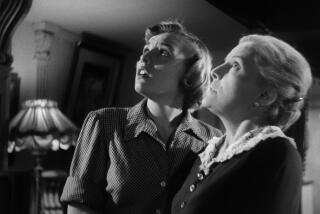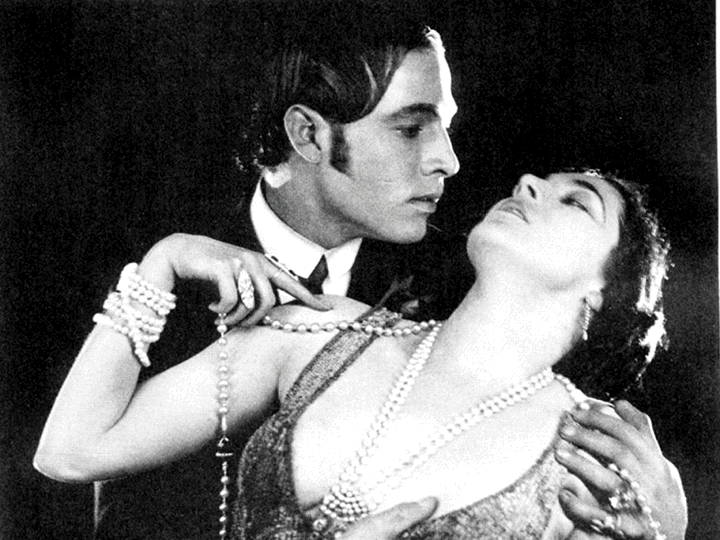The Plot to Restore ‘Vertigo’
- Share via
Two veteran film restoration experts are eager to get their hands on Alfred Hitchcock’s “Vertigo.”
Initially suggested by Martin Scorsese in a letter to Universal Pictures chairman Tom Pollock last fall, restoration of the 1958 classic is being considered by Universal. The project would produce a 70-millimeter widescreen presentation re-creating the quality of the pristine VistaVision version seen by first-run audiences. A newly mastered stereo soundtrack, employing original stereo tapes of Bernard Herrmann’s musical score, would be an added feature.
The prints used in Universal’s 1983 re-release of “Vertigo,” struck from a deteriorating negative, were a pale replica of what the film once looked like, according to various aficionados.
Both Robert Harris, who supervised the 1991 “Spartacus” restoration as well as Columbia’s 1989 restoration of “Lawrence of Arabia,” and former Universal Classics head Jim Katz, who produced the “Spartacus” restoration, are angling to land the “Vertigo” restoration job.
According to one possible scenario, a “Vertigo” laser disc would follow the release of the film in a limited theatrical run. The disc would feature alternative endings that Hitchcock filmed as well as audio-track interviews with the film’s stars James Stewart, Kim Novak and Barbara Bel Geddes.
“There’s an obvious commercial opportunity here,” says Katz. “I can guarantee you that with this restoration, ‘Vertigo’ will look five times better than anyone’s seen since the initial release.”
Haste with the “Vertigo” restoration project is being urged because the original negative “is almost certainly gone, in a near total state of deterioration,” says Harris. He adds that the film’s original color separations “may be shrinking, which would make a restoration especially difficult. So time is a factor.”
A senior Universal executive confirmed recently that “we are trying to do this. We are discussing it with the Hitchcock estate. But it’s a little premature because we haven’t cut a deal yet. We have certain rights but the film essentially belongs to the estate.”
Yet the late director’s daughter Pat Hitchcock, who would have to approve any deal struck between Universal and the Hitchcock estate, said she hadn’t been told about the proposed restoration. “This is the first I’ve heard about it,” she admitted. Asked if she felt that a restoration of “Vertigo” was a good idea, she said, “Well, that would depend on the particulars. I’d have to examine them.”
According to two sources, the Hitchcock estate profited handsomely from Universal’s 1983 re-release of “Vertigo,” “Rear Window,” “The Man Who Knew Too Much” and “The Trouble With Harry.” According to one account, the Hitchcocks received 30% of the $50 million the films reportedly earned from theatrical and home video markets.
Pat Hitchcock’s attorney, Leland Faust, declined to discuss the specifics of the negotiations, except to acknowledge that the issue “came across the table last fall.”
A Universal source said that the studio hopes “to wrap up an agreement within the next couple of weeks. Universal has a relationship with the Hitchcock family that goes back decades.”
Haggling over contractual benefits may be standard practice in any business, but in film restoration, the clock is ticking. The longer the delay, the more negatives deteriorate.
Whether or not “Vertigo” is restored this year or next year is not a critical issue, says Harris. “Creating a new negative could be more or less difficult depending on how soon the work begins,” he relates. “But given the deterioration that has already occurred, another few months isn’t going to make a huge difference.”
But overall, “It’s a bigger problem than most people realize,” Harris comments. “The people at Universal have been very supportive of restoration efforts, but the magnitude of the problem is staggering.”
As Harris explains on the Criterion Collection’s “Spartacus” laser disc, “In the late ‘70s or early ‘80s people would speak of 50% of the films made in the nitrate era being gone, but now we can start counting the color films--especially the large-format films of the ‘50s and early ‘60s--as being the major endangered species.”
Trying to free up rights and raise funding for the restoration of “The Lion in Winter,” the 1968 movie starring Peter O’Toole, Katharine Hepburn and Anthony Hopkins, has consumed nearly three frustrating years of Katz’s time. “You would not believe the hassles we’ve gone through on this,” he says. “And for all of it, nobody’s getting rich. This is not about that--unfortunately.”
More to Read
Only good movies
Get the Indie Focus newsletter, Mark Olsen's weekly guide to the world of cinema.
You may occasionally receive promotional content from the Los Angeles Times.










